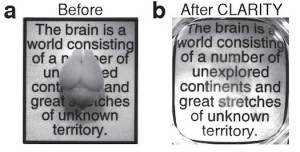
A mouse brain before and after it’s been made transparent using CLARITY.
Image: Kwanghun Chung and Karl Deisseroth, Howard Hughes Medical Institute/Stanford University
Researchers in the biomedical sciences, such as bioelectrochemistry and biomedical engineering, work every day to create new processes and technology that will better the lives of all. The scientific community is recognizing one expert – Karl Diesseroth – for his two innovative techniques that are now widely used to study Alzheimer’s disease, autism, and other brain disorders.
Disseroth has just been awarded the Lurie Prize in Biomedical Sciences for his achievements in the advancement of brain research technology. Disseroth is the pioneer behind a process called CLARITY and the technique called optogenics. In case you missed them, here’s a brief recap:
The process CLARITY uses a series of chemical reactions to stabilize organs and make them transparent to the naked eye. This has allowed scientists to look at organs in a whole new way. Read the article on the process here.
Check out the amazing video of the see-through organs below:
On the other hand, Disseroth’s optogenics technique allows scientist to narrow their focus on specific disorders.
This from Popular Science:
Scientists genetically engineered the mouse so that its brain cells turn certain genes on or off when scientists shine laser light onto them. The light enters the mouse’s brain through that optical fiber you see in the photo. Optogenetics lets scientists perform experiments on genes they may be associated with certain disorders, but whose functions are mysterious.
Head over to the Digital Library to see our most recent papers on new electrochemical biomedical processes.
P.S. Make sure to sign up for our free e-Alerts to stay on top of the latest research in your field.


